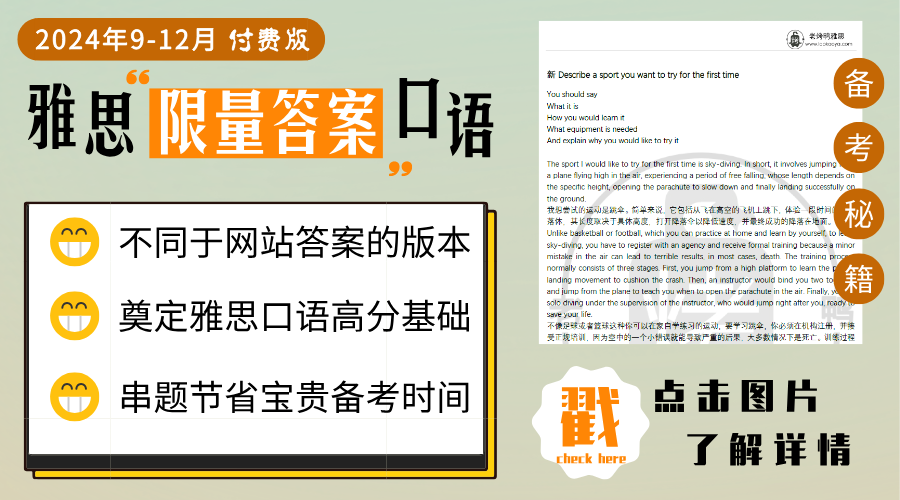剑桥雅思11阅读Test1Passage1原文翻译 crop-growing skyscrappers 垂直农 […]

剑桥雅思11阅读Test1Passage1原文翻译 crop-growing skyscrappers 垂直农业
剑桥雅思11阅读第一套题目第一篇文章的主题为通过垂直农业的方式来解决食物不足的问题。文章一共7段,分别介绍了人类目前所面对的粮食问题,垂直农业的优势,垂直农业的劣势以及相应的解决办法。下面是具体每一段的翻译。
点击查看这篇雅思阅读中需要大家掌握的重点词汇以及对应的答案解析:
雅思真题阅读词汇 剑桥雅思11 test 1 passage 1 垂直农业
剑桥雅思11阅读Test1Passage1答案解析 Crop-growing skyscrapers
剑桥雅思11 Test1 Passage1阅读原文翻译第1段
By the year 2050, nearly 80% of the Earth’s population will live in urban centres. Applying the most conservative estimates to current demographic trends, the human population will increase by about three billion people by then. An estimated 10 hectares of new land (about 20% larger than Brazil) will be needed to grow enough food to feed them, if traditional farming methods continue as they are practised today. At present, throughout the world, over 80% of the land that is suitable for raising crops is in use. Historically, some 15% of that has been laid waste by poor management practices. What can be done to ensure enough food for the world’s population to live on?
到2050年,地球上将有近80%的人口居住在城市中心。将最保守的估计应用于当前的人口发展趋势,到那时,人口将增加约30亿。如果继续采用现在传统的耕作方法,预计需要10的9次方公顷的新土地(比巴西大20%)才能够种出足够的粮食来养活他们。目前,全世界适合耕种农作物的土地中,有80%已被使用。从历史上看,其中约15%由于管理不善而荒废。那么如何才能确保世界人民有足够的食物生存呢?
第2段
The concept of indoor farming is not new, since hothouse production of tomatoes and other produce has been in vogue for some time. What is new is the urgent need to scale up this technology to accommodate another three billion people. Many believe an entirely new approach to indoor farming is required, employing cutting-edge technologies. This is from Laokaoya website. One such proposal is for the ‘Vertical Farm’. The concept is of multi-storey buildings in which food crops are grown in environmentally controlled conditions. Situated in the heart of urban centres, they would drastically reduce the amount of transportation required to bring food to consumers. Vertical farms would need to be efficient, cheap to construct and safe to operate. If successfully implemented, proponents claim, vertical farms offer the promise of urban renewal, sustainable production of a safe and varied food supply (through year-round production of all crops), and the eventual repair of ecosystems that have been sacrificed for horizontal farming.
室内耕作的概念并不是什么新鲜事物,因为温室栽培西红柿和其他农产品已经流行了一段时间。新鲜的是扩展此技术以容纳另外30亿人口的迫切需求。许多人认为,需要利用文章来自老烤鸭雅思尖端技术采用全新的室内耕作方法。而其中一项提议就是“垂直农场”。这一概念是将粮食作物种植在环境条件受控的多层建筑中。它们位于城市中心地带,会急剧减少将食物运送到消费者手中所需要的运输量。垂直农场的效率要高,建造要便宜,运营要安全。支持者声称,如果成功实施的话,垂直农场将会带来城市复兴的希望,持续提供安全多样的食物(一年到头都可以生产各类作物),并最终修复由于水平农业而牺牲的生态系统。
第3段
It took humans 10,000 years to learn how to grow most of the crops we now take for granted. Along the way, we despoiled most of the land we worked, often turning verdant, natural ecozones into semi-arid deserts. Within that same time frame, we evolved into an urban species, in which 60% of the human population now lives vertically in cities. This means that, for the majority, we humans have shelter from the elements, yet we subject our food-bearing plants to the rigours of the great outdoors and can do no more than hope for a good weather year. However, more often than not now, due to a rapidly changing climate, that is not what happens. Massive floods, long droughts, hurricanes and severe monsoons take their toll each year, destroying millions of tons of valuable crops.
人类花了10,000年的时间来学习如何种植我们现在认为理所当然的大多数作物。在此过程中,我们破坏了耕作的大部分土地,经常将翠绿的自然生态区变成半干旱的沙漠。在相同的时间范围里,我们进化成城市物种,其中60%的人口现在在城市中垂直居住。这意味着,对于大多数人来说,我们人类可以躲避各种因素的影响,但我们将生产食物的植物置于严酷的户外条件下,只能祈祷天气良好。然而,由于快速变化的气候,情况并不如人们所愿。洪灾、长期干旱、飓风和严重的季风每年都会造成巨大的损失,摧毁数百万吨宝贵的农作物。
第4段
The supporters of vertical farming claim many potential advantages for the system. For instance, crops would be produced all year round, as they would be kept in artificially controlled, optimum growing conditions. There would be no weather-related crop failures due to droughts, floods or pests. All the food could be grown organically, eliminating the need for herbicides, pesticides and fertilisers. The system would greatly reduce the incidence of many infectious diseases that are acquired at the agricultural interface. Although the system would consume energy, it would return energy to the grid via methane generation from composting non- edible parts of plants. It would also dramatically reduce fossil fuel use, by cutting out the need for tractors, ploughs and shipping.
垂直农业的支持者声称该系统具有许多潜在优势。例如,由于农作物生长在人为控制的、理想的环境中,它们可以整年产出粮食。不会由于干旱、洪水或虫灾等与天气有关的因素而造成粮食欠收。所有食物都可以有机种植,从而消除对除草剂、杀虫剂和肥料的需求。该系统将大大降低在农业接触中感染一些传染病的概率。虽然该系统会消耗能量,但通过利用植物不可食用的部分进行沼气发电,可以将能量返还给电网。通过减少对拖拉机、犁和运输的需求,它也会大量减少化石燃料的使用。
第5段
A major drawback of vertical farming, however, is that the plants would require artificial light. Without it, those plants nearest the windows would be exposed to more sunlight and grow more quickly, reducing the efficiency of the system. Single- storey greenhouses have the benefit of natural overhead light: even so, many still need artificial lighting. A multi-storey facility with no natural overhead light would require far more. Generating enough light could be prohibitively expensive, unless cheap, renewable energy is available, and this appears to be rather a future aspiration than a likelihood for the near future.
然而,垂直耕作的主要缺点在于植物需要人造光。没有它,那些最靠近窗户的植物将暴露在